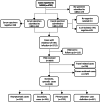The epidemiology, microbiology and clinical impact of Shiga toxin-producing Escherichia coli in England, 2009-2012
- PMID: 25920912
- PMCID: PMC9150938
- DOI: 10.1017/S0950268815000746
The epidemiology, microbiology and clinical impact of Shiga toxin-producing Escherichia coli in England, 2009-2012
Abstract
Between 1 January 2009 and 31 December 2012 in England, a total of 3717 cases were reported with evidence of Shiga toxin-producing E. coli (STEC) infection, and the crude incidence of STEC infection was 1·80/100 000 person-years. Incidence was highest in children aged 1-4 years (7·63/100 000 person-years). Females had a higher incidence of STEC than males [rate ratio (RR) 1·24, P < 0·001], and white ethnic groups had a higher incidence than non-white ethnic groups (RR 1·43, P < 0·001). Progression to haemolytic uraemic syndrome (HUS) was more frequent in females and children. Non-O157 STEC strains were associated with higher hospitalization and HUS rates than O157 STEC strains. In STEC O157 cases, phage type (PT) 21/28, predominantly indigenously acquired, was also associated with more severe disease than other PTs, as were strains encoding stx2 genes. Incidence of STEC was over four times higher in people residing in rural areas than urban areas (RR 4·39, P < 0·001). Exposure to livestock and/or their faeces was reported twice as often in cases living in rural areas than urban areas (P < 0·001). Environmental/animal contact remains an important risk factor for STEC transmission and is a significant driver in the burden of sporadic STEC infection. The most commonly detected STEC serogroup in England was O157. However, a bias in testing methods results in an unquantifiable under-ascertainment of non-O157 STEC infections. Implementation of PCR-based diagnostic methods designed to detect all STEC, to address this diagnostic deficit, is therefore important.
Keywords: Escherichia coli; foodborne zoonoses; gastrointestinal infections; infectious disease epidemiology; zoonotic foodborne diseases.
Figures





References
-
- Armstrong GL, Hollingsworth J, Morris JG. Jr. Emerging foodborne pathogens: Escherichia coli O157: H7 as a model of entry of a new pathogen into the food supply of the developed world. Epidemiologic Reviews 1996; 18: 29–51. - PubMed
MeSH terms
LinkOut - more resources
Full Text Sources
Medical

